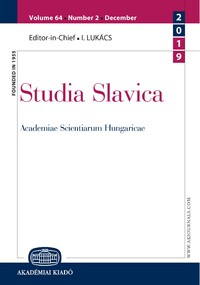(Прото-)гипертекстуальность двойного финала в повести Л. Толстого «Дьявол»
(Proto-)Hypertextuality of the Double End in the Story The Devil by L. Tolstoy
Author(s): Feliks ShteinbukSubject(s): Russian Literature
Published by: Akadémiai Kiadó
Keywords: double end; structural-semantic method; structural-functional method; hypertextuality; proto-hypertextuality; artistic interpretation
Summary/Abstract: The story The Devil by L. Tolstoy has traditionally been interpreted by the Russian literary scholars in two contexts. They either see the writer’s personal experience or they interpret it as a religiously motivated moral and ethical warning that it is vital for a man to resist the devil’s temptations. At least, I have not managed to find any other different approaches to interpret L. Tolstoy’s story in the open sources. The aim of this paper is to analyze and interpret the story The Devil by L. Tolstoy by means of the structural-semantic and structural-functional methods, taking into consideration such a rare artistic phenomenon as the double end, the existing fact of which has not received any professional evaluation and appropriate interpretation in literary studies. Due to the suggested approach, the conclusions are made that the double end of the story under analysis could not happen by chance. First, telling the story of Yevgeny Irtenev, the author turns to an obvious device of withholding, hence the real reason, the hero’s irresistible lust for Stepanida, which drives the main character to act, is demonized and transmitted to the female protagonist obtaining a mystic character. Second, comparing the story The Devil with the novel The Story of O by P. Réage, one can see another double end linked with sexual problematics but with the difference that in the novel by the French writer, this problematics is not concealed but, on the contrary, exhibited. Third, the non-randomness of the double end is affirmed by the fact that, demonizing the lust which overtook the protagonist of the story, L. Tolstoy like P. Réage frees this lust from necessity or determination. Due to the fact that the story happened to have two ends, the sexually motivated Irtenev’s story acquires at least ambivalent, ambiguous, or, in the terms of poetics, non-linear character which, by definition, tends to hypertextuality in case the latter is understood as “a form of brunching or responding text” (T. Nelson). Abiding by the suggested approach, the story by L. Tolstoy can be interpreted as an experimental literary work where breaking the traditional composition structure of the text, on the one hand, is determined by tabooed, i.e. sexual, problematics, which made the author resort to demonization of the latter. On the other hand, the writer opted for the artistic non-linear, alternative end of the story told. The story happened to be potentially hypertextual which, taking into consideration historical technological circumstances, should be identified rather as a proto-hypertextual one. Thus, the original genius of L. Tolstoy foresaw the virtual future of fiction with the proto-hypertextuality phenomenon in the story The Devil.
Journal: Studia Slavica Academiae Scientiarum Hungaricae
- Issue Year: 65/2020
- Issue No: 2
- Page Range: 351-362
- Page Count: 12
- Language: Russian
- Content File-PDF

